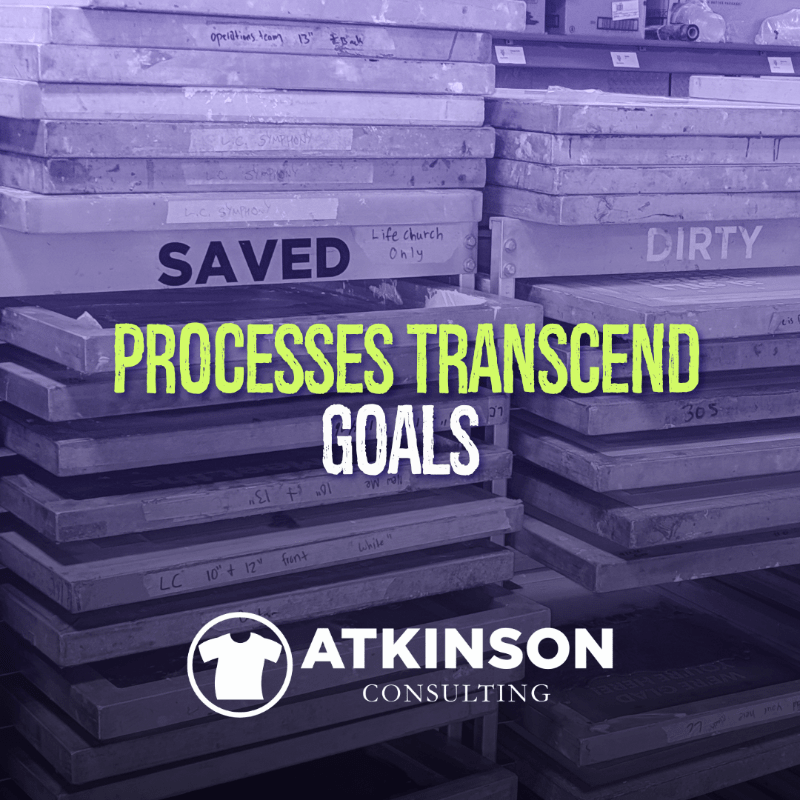In any business, there are plenty of reasons why setting goals is a good thing. For one, it gives us a brass ring to reach.
In fact, I’ve written many articles that are either about setting SMART goals, or used the concept of SMART goals in the piece to describe some action. (Specific, Measurable, Achievable, Realistic, & Timely)
Yet, setting Goals only gets you so far. Plenty of people set goals and then never achieve them. This could be sales goals, weight loss goals, or simply better health goals…like quitting smoking.
In this article, I want to detail some thoughts that focus on why improving your processes in your business can yield better long term results than simply setting a goal and working toward it.
Start With The Definition of Processes
proc·ess noun
plural noun: processes
A series of actions or steps taken in order to achieve a particular end.
“military operations could jeopardize the peace process.”
Synonyms: procedure, operation, action, activity, exercise, affair, business, job, task, undertaking, proceeding.
“faxing a seventy-page document is an expensive process”
Processes Define The Journey
Now think about that. “A series of actions or steps taken in order to achieve a particular end.”
This is why it isn’t enough to set a goal.
Goals setting is great. But without action, it’s meaningless. It’s a transparent idea. It is the process that you build that pushes you toward achieving that goal.
You should be far more concerned with the current path you are on than your current score. Your processes define that journey.
Get To The Next Level
For example, let’s say that you state that you want to “get to the next level” for your shop. I’ve heard that phrase probably a million times in my career in this industry.
What does that even mean?
It could be sales. It’s the million-dollar club. Or the ten-million-dollar club. Maybe more for some people. But it is always out there like an apple that you can’t quite pick off of the tree.
It could be technique. Winning awards and peer recognition. Mastering your craft. Who doesn’t want to be known for their quality?
What about the physical size of the shop? Moving from a garage or basement to an actual location. Building your own facility. Adding more zeroes to your square footage.
The “Next Level” could be anything. For most it’s a pipe dream.
Why?
Because They Lack Processes
As many start out in this industry on a wing and prayer, it isn’t difficult to imagine why they never achieve their goals.
People don’t know what they don’t know.
Some will work crazy hours and “do what it takes” to make it. And still fail.
Because they haven’t spent the time building out their processes. “A series of actions or steps taken in order to achieve a particular end.”
Therefore all that hard work is like driving your car blindfolded. Does that sound like your shop? Zooming off toward wherever with your hair on fire as fast as you can go without a clue?
But here’s the truth: too often people in this industry have convinced themselves that fantastic success only comes after some sort of massive action.
“All I need is one big client” or “Just wait until we get an auto, then our problems will be over!” or “As soon as we launch our new website we’ll be huge!”
That’s where everyone gets it wrong.
Evaluate
So, let’s take a step back and slow down. Evaluate the situation for a minute.
What type of processes are we talking about here anyway?
Well…literally everything you do in your shop. Have you defined each step so there is a “shop way” of doing something?
Or, and this is more common, do you leave it up to your crew to figure it out and the results flow from there.
Sales Processes: The Lifeblood Of Your Shop
Since more sales are the lifeblood of your shop, let’s use that as an example. It’s a good one, as setting sales target goals is something that every shop should be working on constantly.
First, let me ask you this. Would you define your sales process as “Reactive” or “Proactive”. This is important.
A “Reactive” sales process is where the customer contacts your shop and you help them with their order. It’s reactive because your sales growth is tied to people contacting you. No calls = no sales. You are more of an order taker than anything.
A “Proactive” sales process is more aggressive. You are hunting. There is a process in place to identify new customers, reach them, and close the sale. Your sales brain is always a few weeks ahead.
Maybe it is a little mix of both? It’s ok either way. But it is important that you define your processes and improve them continually.
Process Improvement – The 1% Rule
Here’s a nugget that I want to you take away from this article. In anything you do, try to get 1% better every day.
Small, incremental change is where your growth is going to happen.
1%.
Daily.
That doesn’t seem like much does it? However, it’s the effect of compounding that is going to make the difference for your shop.
Although not all improvements are about money, an example to demonstrate the power of what I’m talking about, let’s take $100.
If we compound that daily by 1%, on day 100 it is $270.48.
By years end, it is $3,778.34.
Therefore imagine the payoff to your business if you start trying to make things better by tiny increments.
This could be in more training for your staff. One more cold call to a potential new customer. Redefining your communication for clarity. Actually posting that short video in your shop on Instagram. Sending a “Thank You” card. Building out your automated Drip Campaigns for marketing and client retention. Firing that customer that sends you no-profit work that clogs up your schedule.
It is the accumulation of these tiny wins that pushes you to the success you are seeking.
Processes Last
As I mentioned before, I’m a fan of setting goals. I truly believe we need to understand where we want to go.
However, what happens when you achieve that goal?
Let’s say you do hit the $1,000,000 mark in sales. Does everything just stop?
Nope, because a new goal is going to be set. This time, it will be $2,500,00 or another figure. But what is going to get you there faster is the habit of continually refining and improving.
That 1% compounding every day.
Remember the definition of processes? “A series of actions or steps taken in order to achieve a particular end.” In all facets of your business every time you improve something, you are taking a step to compounding your results.
That 1% is about your shop learning to change and improve.
Consequences of Not Improving Processes
So what happens if you just stay put?
No action.
Nothing is broken, right? Why mess with it?
Well, I hate to be the bearer of bad news but you don’t live in a bubble. The world is evolving all the time.
How is your shop evolving?
Or, better yet, how is your competition evolving? Is someone poised to eat your lunch? There are plenty of horror stories from other industries that tell the tale of not adapting.
Don’t let that be you.
Define Your Processes
This isn’t hard. It’s just work.
Start with any core task in your shop. Take a snapshot of how the work is being performed now. Document:
- Who is doing the work?
- What is the work?
- When is it due?
- Where in the shop is work?
- What other departments influence their work?
- How is success defined?
You don’t need anything fancy. A notepad and a pencil will do. Maybe even record the process with photos or video from your phone.
Want to get more professional about it? Use this free tool to chart your processes.
The important part here is that there are friction points, bottlenecks, and landmines in your processes that can use some adjustment. Can you remove a step? Is there a way to automate it? How can technology handle something to help?
Your goal is to improve something so that it is improved forever.
What If You Don’t Have A Process?
That’s ok too. Describe how you do it now. Don’t be afraid.
For example, plenty of shops don’t have a well-defined process for creating art, checking in inventory, quoting, or even scheduling jobs.
Not the end of the world.
To start your improvement after you have charted your current method is to think about “How” it should work. What’s the best way that someone else might be doing it? Would that work for you?
What’s preventing you from adopting that in your shop? Time? Money? Experience? Tools?
Don’t fret. You need to simply map it out and start. Remember, we want a 1% improvement daily.
Not 100% improvement.
1%.
Think smaller.
Rather than redesigning the entire Receiving department process, what if today you nailed down how box labels are printed and applied to cartons? Tomorrow, it’s how packing slips are sorted.
Process Habits
Remember, continuous improvement never ends. It is the habit of always working toward improving every facet of your shop that I’m advocating here.
As anyone who has ever tried to lose weight before the summer swimsuit season can attest, just because you set a goal doesn’t mean you will achieve it. It is the daily accumulation of everything that you put into it that helps you get there.
Eat a salad or an entire pepperoni pizza? Be a couch potato or go to the gym? Keep things a secret or post your weight score online or on the fridge? Do it alone or share the experience with a group?
Which of these choices can influence the outcome? You know the answer already.
Your Processes
It is the same in your shop with what you want to achieve.
You can’t hit your sales goals if you aren’t constantly refining your strategy and tactics to acquire new customers. For those three Yeses, maybe you had to get seven No’s.
Which means for thirty Yeses, you might need seventy No’s.
But what if you aren’t getting the opportunity to get a Yes or a No? Maybe you are waiting for your customers to walk through the door? With zero traffic that isn’t quite working.
If you aren’t getting the results you want, you need to rethink your processes.
Build New Habits
So that might mean you need to build new habits. A habit is a behavior that is performed on a regular basis.
“I drink two cups of coffee every morning” is a habit.
Just like “I phone four potential customers every day by lunch” or “I post two pics to Instagram daily.”
Maybe you don’t like the habits that your shop seems to have. That’s ok. You can define what they should be.
You decide the type of shop you envision.
The habits that you instill will work to become the type of shop that you are dreaming about. That’s your focus.
Prove it to yourself every day with those 1% victories.
.
.
“Almost all quality improvement comes via simplification of design, manufacturing…layout, processes, and procedures.” – Tom Peters
“Positivity is like a muscle: keep exercising it and it becomes a habit.” – Natalie Massenet
“Only I can change my life. No one can do it for me.” – Carol Burnett
.
.





